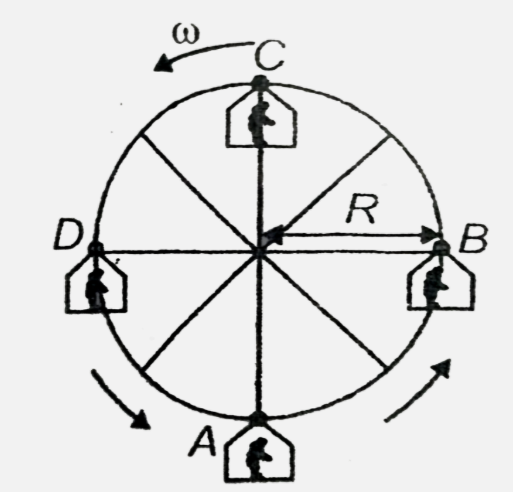Following figure shows a giant wheel that you must have seen in a fair . The wheel rotates with a constant angular speed ω Your younger brother is standing in one of the boxes that are fitted at the periphery of the wheels . So, he is also in a state of uniform circular motion in a vertical pane . (##AAK_T1_PHY_C03_E05_011_Q01.png" width="80%">
If your brother stands vertically without holding anything in the box , which of the following forces provides centripetal force to him at position B.
Resultant of weight and normal reaction
Friction between your brother and floor of the box
Force on the honge at which box is suspended
Normal reaction between floor and your brother
The correct Answer is:B
Topper's Solved these Questions
- LAWS OF MOTIONBOOK - AAKASH INSTITUTECHAPTER - LAWS OF MOTIONEXERCISE - ASSIGNMENT ( SECTION -E) Assertion - Reason Type Questions
8 Videos
- LAWS OF MOTIONBOOK - AAKASH INSTITUTECHAPTER - LAWS OF MOTIONEXERCISE - ASSIGNMENT ( SECTION -G ) Integer Answer Type Questions
2 Videos
- LAWS OF MOTIONBOOK - AAKASH INSTITUTECHAPTER - LAWS OF MOTIONEXERCISE - ASSIGNMENT ( SECTION -D) Linked Comprehension Type Question (Comprehension -II) (Choose the correct answer :)
1 Videos
- KINETIC THEORYBOOK - AAKASH INSTITUTECHAPTER - KINETIC THEORYEXERCISE - EXERCISE (ASSIGNMENT) SECTION - D Assertion - Reason Type Questions
10 Videos
- MAGNETISM AND MATTER BOOK - AAKASH INSTITUTECHAPTER - MAGNETISM AND MATTER EXERCISE - ASSIGNMENT (SECTION D)
26 Videos
Similar Questions
Following figure shows a giant wheel that you must have seen in a fair . The wheel rotates with a constant angular speed ω Your younger brother is standing in one of the boxes that are fitted at the periphery of the wheels . So, he is also in a state of uniform circular motion in a vertical pane .

If your brother stands vertically without holding anything in the box , which of the following forces provides centripetal force to him at position B.
View SolutionFollowing figure shows a giant wheel that you must have seen in a fair . The wheel rotates with a constant angular speed ω Your younger brother is standing in one of the boxes that are fitted at the periphery of the wheels . So, he is also in a state of uniform circular motion in a vertical pane .

Let N be the normal reaction between your brother and floor of the box . select the correct alternative .
View Solution
Knowledge Check
The general motion of a rigid body can be considered to be a combination of (i) a motion of its centre of mass about an axis, and (ii) its motion about an instantaneous exis passing through the centre of mass. These axes need not be stationary. Consider, for example, a thin uniform disc welded (rigidly fixed) horizontally at its rim to a massless, stick as shown in the figure. When the disc-stick system is rotated about the origin on a horizontal frictionless plane with angular speed ω the motion at any instant can be taken as a combination of (i) a rotation of the disc through an instantaneous vertical axis passing through its centre of mass (as is seen from the changed orientation of points P and Q). Both these motions have the same angular speed ω in this case

Now consider two similar system as shown in the figure: Case (a) the disc with its face vertical and parallel to x-z plane, Case (b) the disc with its face making an angle of 45∘ with x-y plane and its horizontal diameter parallel to x-axis. In both the cases, the disc is welded at point P, and the systems are rotated with constant angular speed ω about the z-axis.

Which of the following statements regarding the angular speed about the instantaneous axis (passing through the centre of mass) is correct?A√2gRB√3gRC√gRD√gRIn the figure shown
(##AHT_PGT_PHY_C10_E01_006_Q01.png" width="80%">AP>P0BP<P0CP=P0DP=0(##SASA_NJA_OBJ_BIO_V02_C04_E03_039_Q01.png" width="80%">
A(A)(B)(C)(D)iiiiviiiB(A)(B)(C)(D)iviiiiiiC(A)(B)(C)(D)iviiiiiiD(A)(B)(C)(D)iiiiiivi
Following figure shows a giant wheel that you must have seen in a fair . The wheel rotates with a constant angular speed ω Your younger brother is standing in one of the boxes that are fitted at the periphery of the wheels . So, he is also in a state of uniform circular motion in a vertical pane .

Let N be the normal reaction between your brother and floor of the box . select the correct alternative .
View Solution(#FIITJEE_PHY_MB_02_C01_SLV_052_Q01.png" width="80%">
View SolutionThe IUPAC name of (##GRB_ORG_CHM_P1_C03_E03_046_Q01.png" width="80%">
View SolutionThe output across the load resistance R is
(##AAK_P7_NEET_PHY_SP7_C29_E04_031_Q01.png" width="80%">
View SolutionMatch the following ( ##AAK_MCP_10_NEET_BOT_E10_027_Q01.png" width="80%">
View Solution
